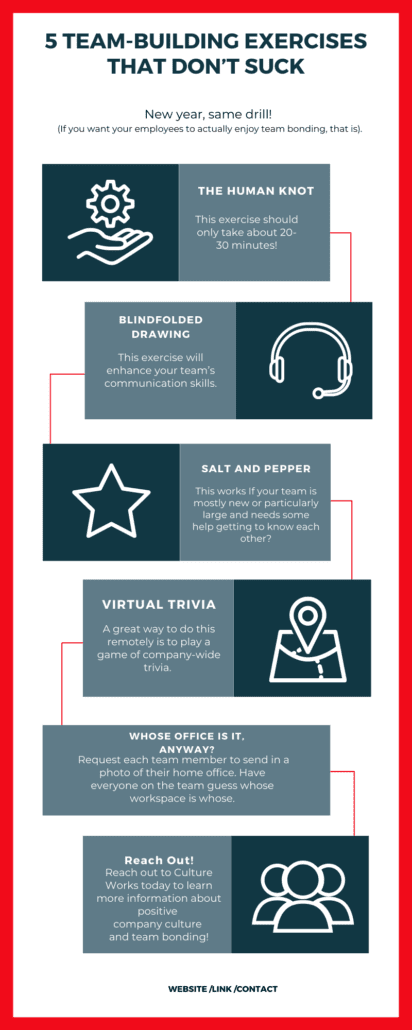5 Team-Building Exercises That Don’t Suck
Here, stand on a table and fall backward into my arms: 5 team-building exercises that don’t suck
New year, same drill! (If you want your employees to actually enjoy team bonding, that is).
Picture this: your manager walks into your office, tells you to be in the common room in 15 minutes for ‘team-building’ exercises. What’s your first instinct? Speaking from experience… we’d argue you’re thinking “run!”
But what if we told you the days of dreaded, forced team-building exercises are over? Believe it or not, it’s possible to make team-building a positive experience for everyone involved. We know… ground-breaking.
In order to make team-building effective and fun, you need to gain your team’s buy-in. In other words, you need to understand your team members.
For some teams, a beach bonfire or a backyard BBQ will be enough to bring employees together. Other teams, however, may want something structured, exercises that can be done in the office together, or team-building that can be completed in 20 minutes. If that sounds like a better fit for your team, here are a few simple, effective team-building exercises for you to try today!
The Human Knot
Depending on your team’s ability to communicate with each other, this exercise should only take about 20-30 minutes! You can include anywhere between 8-20 people in this activity. Start by creating a circle with your team with everyone standing shoulder to shoulder.
Once everyone is in the circle, each member puts their right hand out and grabs someone across the circle. Then, have them repeat this with their left hands. Once everyone is holding two different people’s hands, it’s time to untangle!
This team-building activity builds communication, teamwork, and comradery between coworkers. Disclaimer: this may be a better activity to try out post-pandemic.
Blindfolded Drawing
This next team-building activity, blindfolded drawing, can serve as a socially distanced option! This exercise will enhance your team’s communication skills.
For this exercise, one person has a pen and paper, the other has a picture of the organizer’s choice. The employee with the picture has to describe in detail how to draw what they’re looking at. The employee with a pen and paper has to interpret what the other is saying and draw what they think they are describing. This one is sure to solicit some laughs!
Salt and Pepper
Is your team mostly new or particularly large and needs some help getting to know each other? If so, this activity is perfect for you!
Ensure you have an even number of participants before beginning. Start by creating a list of well-known pairs (salt/pepper, peanut butter/jelly, yin/yang … you get the idea) and write these pairs on separate pieces of paper.
Once all pairs are written, tape one word on each person’s back– but don’t let them see it! After everyone has a word, allow everyone to mingle. Players are only allowed to ask yes or no questions to try to figure out what their tag says.
Once they’ve figured out their word, they need to find their pair. After everyone has found their partner, instruct them to sit down and discuss 3 things they have in common or 3 interesting facts about one another.
Virtual Trivia
Even in remote situations, team building is important. As many companies continue to work remotely in 2021, it’s important to implement a few team-building activities to boost morale and connect teams. A great way to team-build remotely is to play a game of company-wide trivia.
In order to facilitate this event, you’ll need a host to ask questions, count answers, and keep score. Divide your team into smaller teams and organize breakout rooms in Zoom so they can discuss each set of questions. Each section of questions should include about 5-10 questions.
Think about common trivia subjects, but also get creative! You can even include a company trivia section with questions about your CEO and leadership team.
Whose Office Is it, Anyway?
Another way for your team to bond while working remotely is to play ‘Whose Office is it, Anyway?’ Request for each team member to send in a photo of their home office. Have everyone on the team guess whose workspace is whose.
Continue the game with Whose Coffee Mug is it, Anyway? Whose desktop background is it Anyway? And Whose View is it Anyway? This is a simple, easy, and quick way to unify your team and have some fun while they’re out of the office.
As we mentioned before, team building doesn’t have to be something your employees dread. Think of a few simple ways to create a community within your company, while hopefully sharing a laugh!
For those interested in learning more about how to nail your remote company culture, read on here.





